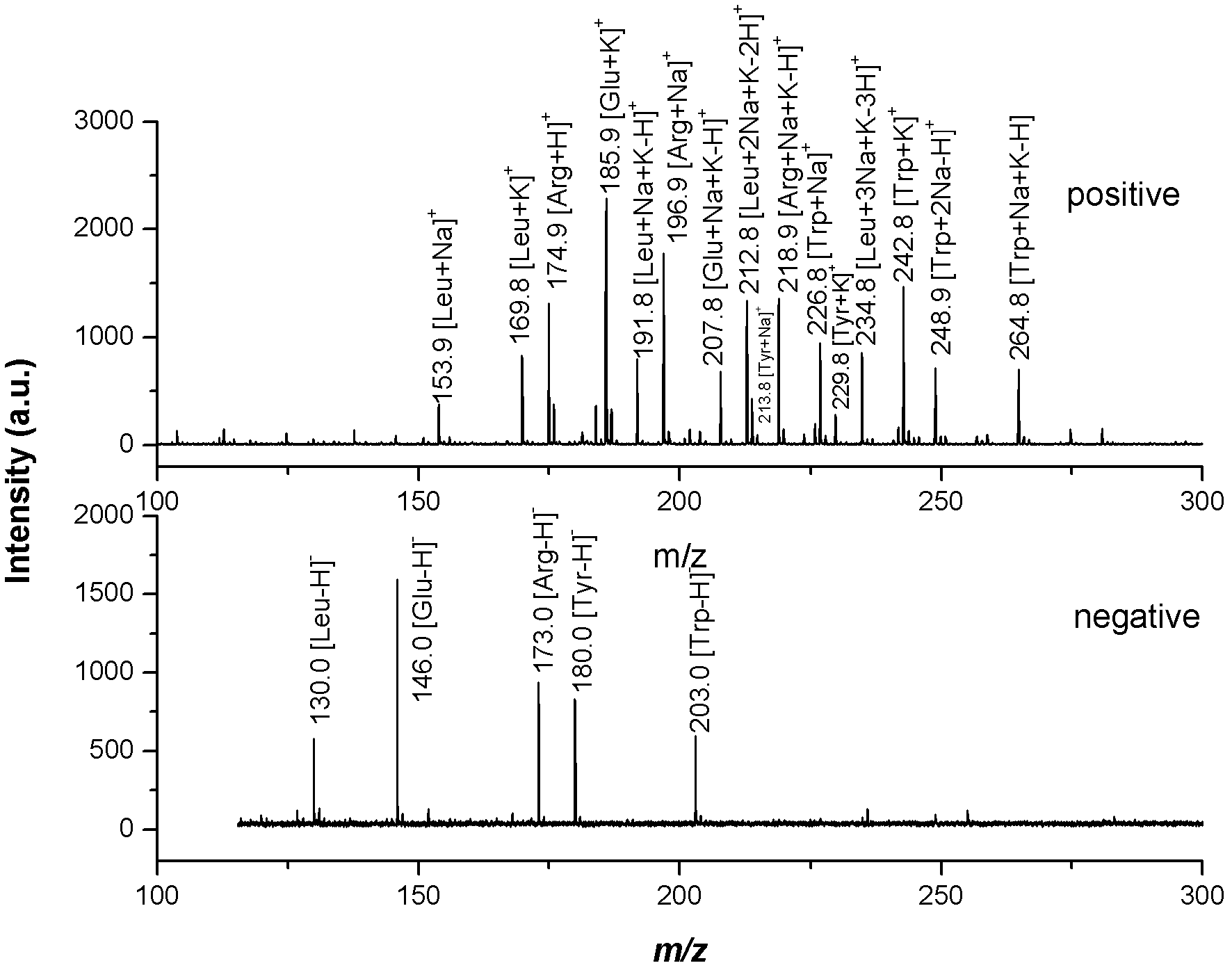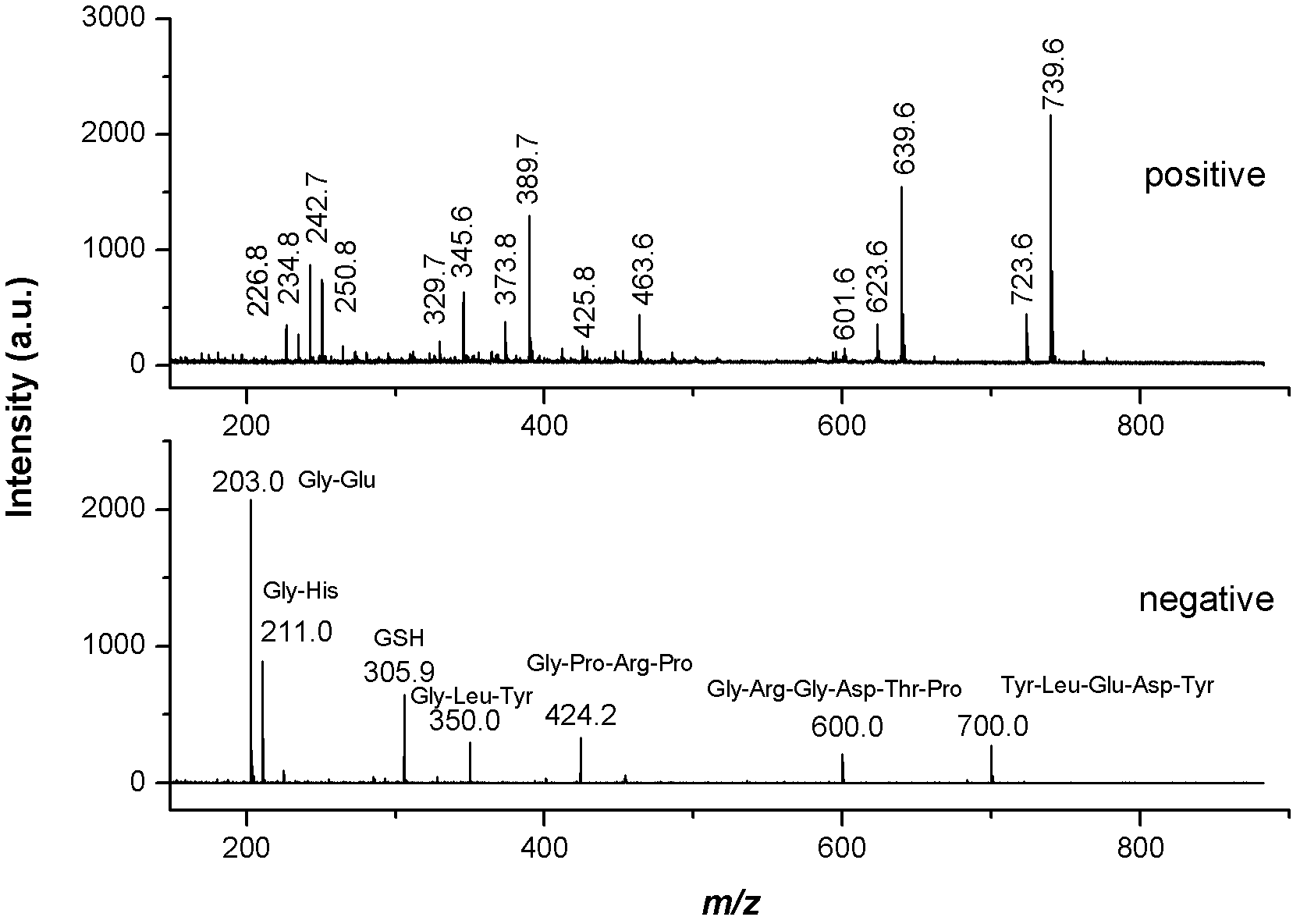Application for analyzing micromolecules with irradiating nanometer carbon spots serving as matrix assisted laser desorption ionization (MALDI) matrix
A technology of nano carbon dots and small molecules, which is used in the analysis of materials, material analysis by electromagnetic means, measurement devices, etc., can solve problems such as instrument damage, low sensitivity, and reduced analysis effect, and achieve reduction requirements and sample compatibility. Good results
- Summary
- Abstract
- Description
- Claims
- Application Information
AI Technical Summary
Problems solved by technology
Method used
Image
Examples
Embodiment 1
[0038] Example 1. Analysis of various small molecules (including amino acids, small peptides, β-agonists, fatty acids, polymers, etc.)
[0039] Take various prepared sample solutions (concentration of 1mM) and matrix (carbon dots) solution (concentration of 1mg / mL) and mix them uniformly at a volume ratio of 1:1, then add 1 μL of the mixed sample to the MALDI target plate, and dry in the air Enter mass spectrometry. The mass spectrometry conditions are: voltage: accelerating voltage: 19.000kv; delayed extraction voltage: 14.920kv; reflector voltage: 20.000kv; lens voltage: 7.000kv; frequency: 1.000Hz; laser energy: 75-80%; accumulation times: 90 times ; positive or negative ion mode.
[0040] In the MALDI ionization mode, the matrix can absorb the laser energy and transfer it to the analyte to ionize the analyte. In the positive ion mode, protonation and alkali metal addition peaks can be formed, and in the negative ion mode, a deprotonation peak can be formed, which can be d...
Embodiment 2
[0041] Embodiment 2, the analysis of uric acid in the urine sample
[0042] Take 2 mL of fresh urine from healthy male volunteers without any sample pretreatment, then take 1 μL and mix it with 1 μL carbon-based (particle) solution (concentration: 1 mg / mL), and finally take 1 μL of the mixed solution and add it to the MALDI target plate. After drying in air, it was subjected to mass spectrometry analysis. The mass spectrometry conditions are: voltage: accelerating voltage: 19.000kv; delayed extraction voltage: 14.920kv; reflector voltage: 20.000kv; lens voltage: 7.000kv; frequency: 1.000Hz; laser energy: 75-80%; accumulation times: 90 times ; Negative ion mode.
[0043] From Figure 7 It can be seen from the figure that in the negative ion mode, except for uric acid molecules, other small molecules have no signal peaks, which may be because the content of other substances that can peak in the negative ion mode is very low, and no mass spectrum signal is generated under the c...
PUM
 Login to View More
Login to View More Abstract
Description
Claims
Application Information
 Login to View More
Login to View More - R&D
- Intellectual Property
- Life Sciences
- Materials
- Tech Scout
- Unparalleled Data Quality
- Higher Quality Content
- 60% Fewer Hallucinations
Browse by: Latest US Patents, China's latest patents, Technical Efficacy Thesaurus, Application Domain, Technology Topic, Popular Technical Reports.
© 2025 PatSnap. All rights reserved.Legal|Privacy policy|Modern Slavery Act Transparency Statement|Sitemap|About US| Contact US: help@patsnap.com



